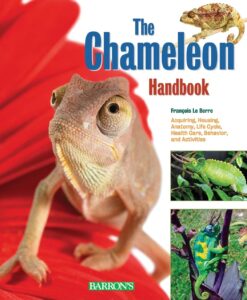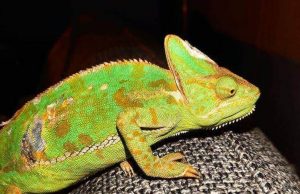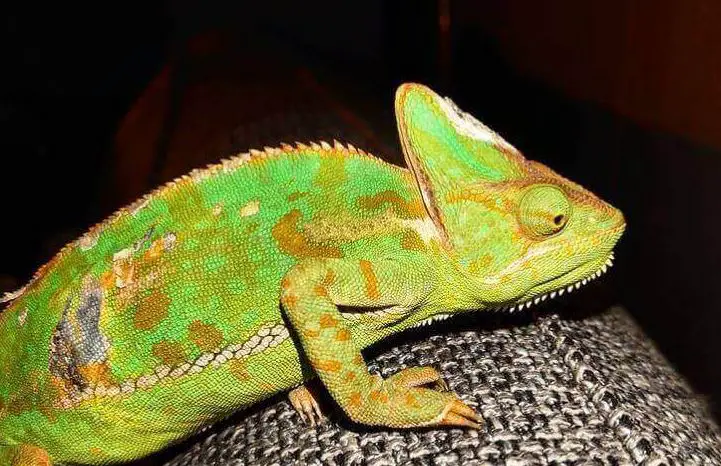How big do chameleons get
A World of Wonder: Chameleons Unveiled
How big do chameleons get: Chameleons, nature’s marvels, have captivated the imaginations of both scientists and enthusiasts for centuries. These remarkable creatures, belonging to the family Chamaeleonidae, are renowned for their extraordinary ability to change colors and blend seamlessly into their surroundings. Found predominantly in the tropical regions of Africa, Madagascar, and parts of Asia, chameleons boast a diverse array of species with fascinating adaptations that make them one of the most intriguing creatures on Earth.
A Kaleidoscope of Colors: The Enigma of Chameleon Size
 While their chameleon-like color-changing abilities often take center stage, there is another aspect that demands our attention – size. Chameleons come in a wide range of sizes depending on the species, from diminutive miniatures to formidable giants.
While their chameleon-like color-changing abilities often take center stage, there is another aspect that demands our attention – size. Chameleons come in a wide range of sizes depending on the species, from diminutive miniatures to formidable giants.
The question that arises then is how big can these enigmatic reptiles truly become? In this article, we will embark on a captivating exploration into the dimensions and variations within the realm of chameleon size.
Through an examination of small-sized chameleons such as Brookesia minima, medium-sized species like Furcifer pardalis and Trioceros jacksonii, all the way up to colossal examples like Calumma parsonii, we will unravel the secrets behind these magnificent creatures’ growth patterns. With each subsequent section delving deeper into specific size categories within this diverse family, prepare to be enthralled by intricate details and awe-inspiring measurements.
Let us embark on a journey through the kaleidoscope of colors and dimensions that make up this fascinating world known as chameleon size. Brace yourself for astonishing discoveries as we uncover just how small or large these beguiling reptiles can truly be.
General Size Range of Chameleons
Chameleons, those captivating creatures known for their remarkable ability to change colors, display a wide range of sizes that vary significantly depending on their respective species. From the minuscule to the massive, these unique reptiles can captivate us with their diverse dimensions. Understanding the general size range of chameleons allows us to appreciate their astounding diversity and adaptability.
Explanation that chameleon size varies depending on species
The fascinating aspect of chameleon size lies in its variability across different species. While some species remain relatively petite throughout their lives, others grow into impressive giants within the reptilian kingdom.
This size discrepancy arises due to various factors such as genetics, environment, and evolutionary adaptations. In general, smaller chameleon species tend to inhabit dense vegetation where they must navigate intricate foliage or narrow branches.
Their diminutive size assists them in maneuvering efficiently through these challenging habitats while reducing the risk of being spotted by predators or prey alike. Comparatively larger chameleons often inhabit more open areas where their expanded dimensions provide advantages like increased reach and an improved field of vision.
Mention of small, medium, and large-sized chameleons
The world of chameleons boasts a vast array of sizes ranging from dainty dwarfs to magnificent giants. At one end of the spectrum resides avian-like marvels such as Brookesia minima, one of the tiniest known chameleon species measuring only 2-3 centimeters in length and weighing less than a gram.
These miniature wonders are adored for their extraordinary camouflage abilities and delicate features. In the middle realm lie medium-sized marvels like Furcifer pardalis, commonly known as panther chameleons; they measure around 30-50 centimeters and can weigh up to 200 grams.
These charismatic chameleons are renowned for their vibrant color patterns and the mesmerizing ability to change hues depending on their surroundings or emotional state. Trioceros jacksonii, commonly known as Jackson’s chameleons, also fall under this category with similar size ranges.
At the other end of the spectrum reside the grandiose behemoths. Calumma parsonii, or Parson’s chameleon, reigns supreme as one of the largest species in existence.
These colossal creatures can reach lengths of up to 68 centimeters and tip the scales at a weight ranging from 500 grams to over a kilogram. With their imposing stature, horn-like protrusions, and stunning coloration, Parson’s chameleons leave an indelible impression on all who encounter them.
Small-Sized Chameleons
Within the mesmerizing world of chameleons, there exists a fascinating subset of diminutive creatures that captivate with their miniaturized features and astonishing ability to blend seamlessly into their surroundings. Among these enchanting beings is the Brookesia minima, hailed as one of the smallest known species in the chameleon kingdom. With its petite size and remarkable attributes, this creature exemplifies nature’s unique artistry.
The Brookesia minima showcases an extraordinary compactness rarely seen in the animal kingdom. Unlike its larger relatives, this marvel measures a mere 2 to 3 centimeters in length, making it comparable to the size of an average human thumb.
Weighing less than a gram, it is virtually weightless when compared to other chameleon species. Its delicate frame displays impeccable refinement and elegance.
What sets the Brookesia minima apart from its larger counterparts is its unparalleled ability to camouflage effectively within its environment. Its diminutive stature allows it to effortlessly hide among foliage and blend harmoniously with its surroundings.
Adorned with hues ranging from earthy browns to vibrant greens, this tiny chameleon has mastered the art of concealment. Whether nestled amidst leaves or perched upon tree branches, it seamlessly merges into its habitat like a living masterpiece painted by Mother Nature herself.

Medium-Sized Chameleons
When discussing medium-sized chameleons, two species stand out for their remarkable characteristics and popularity among reptile enthusiasts – the Furcifer pardalis, commonly known as the panther chameleon, and the Trioceros jacksonii, also recognized as Jackson’s chameleon. Both species belong to the Chamaeleonidae family and exhibit captivating traits that make them highly sought after in the world of exotic pet keeping.
Panther chameleons, scientifically referred to as Furcifer pardalis, are native to Madagascar and showcase an intriguing array of features. These marvels of nature typically measure around 30-50 centimeters in length when fully grown, with males usually being larger than females.
They weigh between 100-200 grams on average, although exceptional individuals can reach up to 250 grams. One of the most striking aspects of panther chameleons is their extraordinary ability to change coloration.
Their skin exhibits a vibrant palette comprising various shades such as reds, greens, blues, yellows, and more. This color-changing ability serves multiple purposes for these creatures.
Not only does it aid in communication with conspecifics or potential mates by displaying dominance or reproductive readiness through bright hues but it also allows them to blend seamlessly into their surroundings for camouflage purposes. The color patterns displayed by panther chameleons are influenced not only by external factors such as light intensity and temperature but also by internal factors like mood or emotional state.
 When agitated or threatened, they may show dark colors with contrasting bands or spots in an attempt to ward off potential predators. The intricate details and dynamic nature of their coloration make observing these creatures a truly mesmerizing experience.
When agitated or threatened, they may show dark colors with contrasting bands or spots in an attempt to ward off potential predators. The intricate details and dynamic nature of their coloration make observing these creatures a truly mesmerizing experience.
Medium-sized chameleons, particularly the panther chameleon and Jackson’s chameleon, exhibit fascinating characteristics that captivate both scientists and reptile enthusiasts alike. Panther chameleons, ranging from 30-50 centimeters in length and weighing up to 200 grams, are renowned for their ability to change colors based on mood or environment.
Their vibrant hues and intricate patterns offer a visually captivating spectacle that showcases the marvels of nature’s artistry. Whether studying these creatures for scientific purposes or admiring them as pets, medium-sized chameleons provide an enchanting glimpse into the diverse world of reptiles.
Large-Sized Chameleons
The Majestic Calumma parsonii (Parson’s Chameleon)
When it comes to chameleons, the Calumma parsonii, commonly known as Parson’s chameleon, stands tall—quite literally. As one of the largest chameleon species in existence, this magnificent creature never fails to capture our awe. With an impressive length measuring up to 68 centimeters, Parson’s chameleon commands attention and admiration wherever it roams.
Weight Range and Physical Magnificence
The weight range of the Parson’s chameleon is equally remarkable for its size. Typically weighing between 500 grams to over a kilogram, these gentle giants carry a significant presence in their natural habitat of Madagascar. However, their size alone is not what sets them apart; their physical traits are equally captivating.
One striking feature of the Parson’s chameleon is its horn-like protrusions often found on males. These protrusions add a touch of grandeur and regal charm to an already magnificent creature.
Additionally, their vibrant coloration steals the show—a kaleidoscope of greens, blues, reds, and yellows adorns their scales. This dynamic color palette not only helps them blend with their surroundings but also serves as a visual spectacle that mesmerizes all who behold it.
Factors Influencing Chameleon Size
The Role of Genetics in Chameleon Size Variation
 When pondering the varying sizes among chameleons within a single species or even across different species altogether, genetics emerges as a crucial factor that shapes these differences. Genetic factors play an intricate role in determining whether a chameleon will be small-sized like Brookesia minima or large-sized like Calumma parsonii. Within each species’ gene pool, nature weaves a tapestry of genetic diversity, resulting in chameleons displaying a wide range of sizes and characteristics.
When pondering the varying sizes among chameleons within a single species or even across different species altogether, genetics emerges as a crucial factor that shapes these differences. Genetic factors play an intricate role in determining whether a chameleon will be small-sized like Brookesia minima or large-sized like Calumma parsonii. Within each species’ gene pool, nature weaves a tapestry of genetic diversity, resulting in chameleons displaying a wide range of sizes and characteristics.
Interactions between genetic material passed down from parents to offspring determine the potential size that individual chameleons can reach. Environmental factors also play a significant role in activating or suppressing certain genes, further influencing overall size and growth patterns.
TO sum up how big do chameleons get
In our exploration of how big chameleons can get, we have encountered a fascinating array of sizes and physical attributes. From the minuscule Brookesia minima to the magnificent Calumma parsonii, these remarkable creatures offer glimpses into the wonders of nature’s design. As we unravel the complex interplay between genetics and environmental factors affecting chameleon size, we are reminded of the endless possibilities that exist within our world.
The sheer diversity among these incredible creatures ignites our curiosity and appreciation for life’s intricate tapestry. Let us revel in the grandeur of nature’s creations, taking solace in the fact that even in the face of immense variation, there is an inherent beauty that binds us all.
Further Reading:
- Best Turtle Substrate For Your Pet Tank
- Coconut substrate for chameleons
- Caught my Chameleon eating moss


